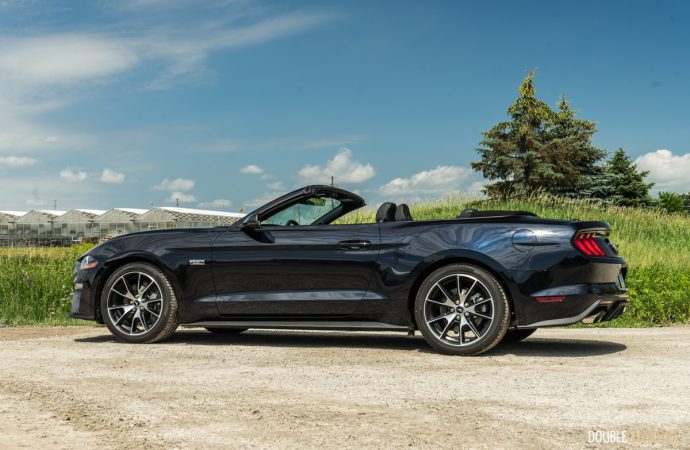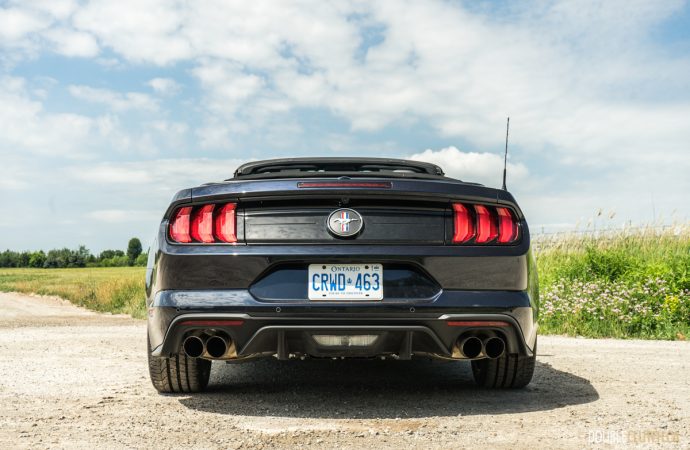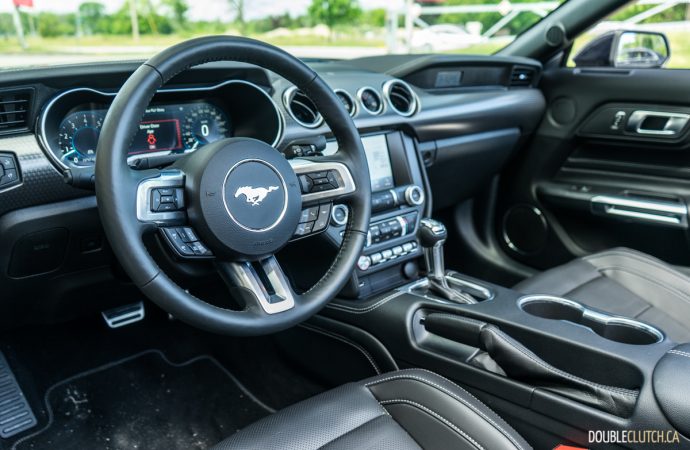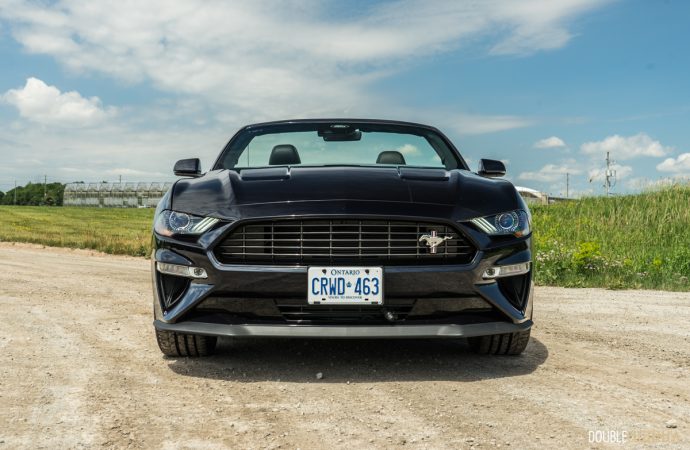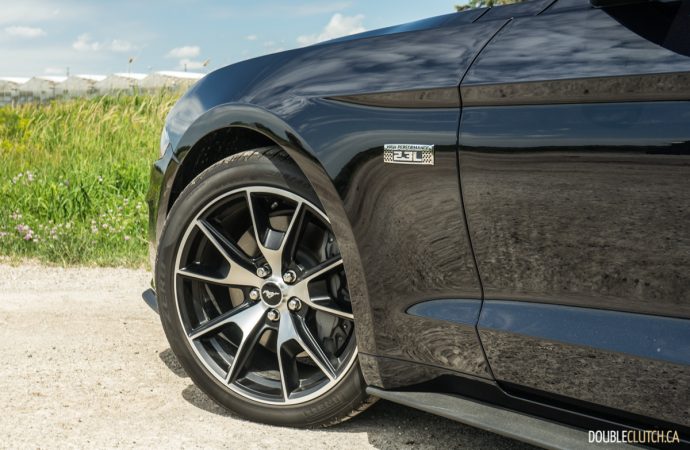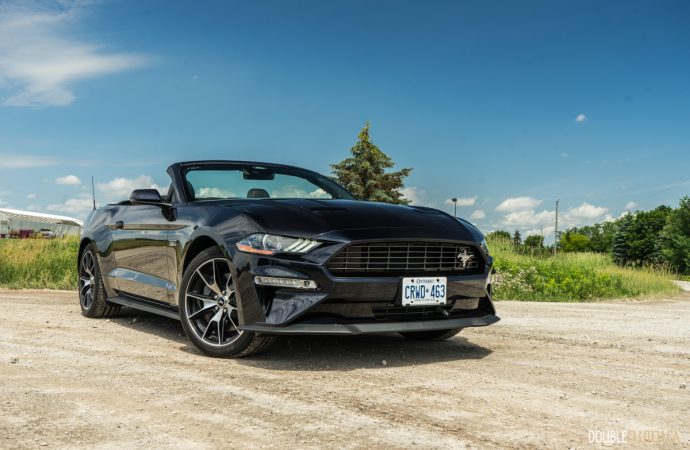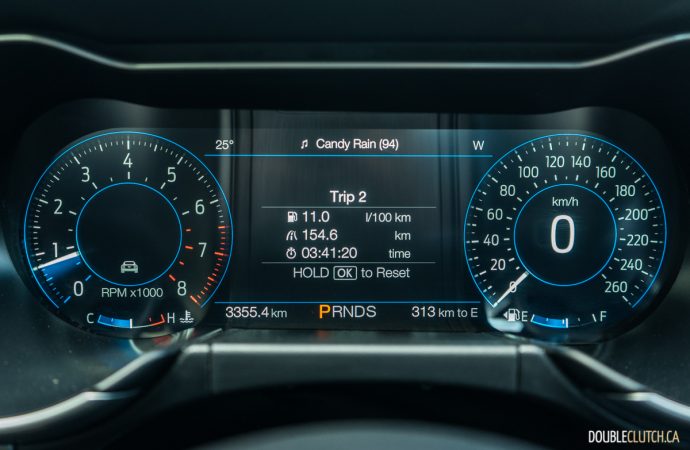If you’re not looking to blow a ton of money on a fancy European convertible, there are only a handful of affordable ragtops out there, with the iconic Ford Mustang being by far the most popular choice. We decided to spend a hot summer week with a 2021 Ford Mustang EcoBoost Convertible, with the new High Performance version of the EcoBoost four-cylinder.
The Mustang is now in its sixth generation, which was originally released for the 2015 model year. The car looks exactly like, well, a Mustang. It carries one of the most iconic shapes in the industry and merges a nice balance between aggression and tastefulness into its styling. It’s more conservative looking than a Camaro or a Challenger but doesn’t lose any of its domineering road presence.
What’s really interesting though is the seemingly endless number of configurations with which you can option a Mustang from the factory. It’s an extremely common car in the Toronto area, but you’d be hard pressed to find two that look alike. It’s available in ten different colors, six stripe options, and depending on the package, a few different wheel options as well.
Opting for the High Performance 2.3-liter engine does tweak the exterior a little bit as well. This adds tasteful textured black skirts, a front splitter, rear diffuser, unique grille, spoiler delete and fender emblems. It also comes with a great looking quad outlet exhaust system similar to the GT model, which really helps this Mustang look like a proper muscle car.
The interior layout remains one of the Mustang’s strongest points, even though it has been close to seven years since the interior has had a proper revamp. It is lacking a little bit in terms of material quality and finish, but the overall space is a very nice place to be. It does have a way of making you feel like you’re in a proper muscle car, thanks to the “engine spun” faux-aluminum trim on the dash and prominently placed oil pressure and boost gauges, also added with the Performance Package.
Being a Premium trim, our tester came with leather seats that are comfortable, supportive and include adjustable lumbar. They are heated and ventilated, but oddly the backrest adjustment is manual only – which has to do with providing easy access to the rear seats. Storage up front is pretty generous, with decent console cupholders, deep door pockets and a usable center console storage cubby.
The rear seats don’t offer much at all in the way of legroom, and access with the top up requires some gymnastics. That said, putting the top down makes access a lot easier, making the Mustang a family friendly top-down cruiser. Most kids will happily deal with the cramped legroom for a ride, and having driven a few Mustangs over the years I can confirm that they will fit not just a forward facing child seat, but even a rear facing infant seat as well.
The trunk is fairly long, shallow and the opening is awkwardly small, making it difficult to get anything bulky inside. It’s great for a large grocery run, but not so great for strollers or coolers which require some fiddling to get in. It’s not that a Mustang is intended for family hauling, but it is nice to be able to go out for a family drive in a convertible and leave the SUV at home.
Good looking, comfortable and somewhat practical it is, but without the V8, is the Mustang really a proper performance car? Well, the new high performance version of the 2.3-liter offers 330 horsepower and 350 lb-ft. of torque at 3,000RPM. The high performance tune used on the EcoBoost 2.3-liter to squeeze the extra 20 horses out of it does change its character a bit, and may not be worth the extra power depending on how you plan to use the car.
This engine is well suited to spirited driving. In “Sport” mode, it’s quick to respond and offers plenty of power and torque. There’s more than enough power here for just about any sort of street driving you’d want to do. The downside is that the more aggressive tune means that the turbo seems to lag a little more at lower RPMs, and then comes on stronger once it is spooled up, which makes for a less refined experience.
The active exhaust is loud, as you’d expect from a Mustang, but the sound is much more sport-compact than the throaty sound of a muscle car. This engine would be better paired to the standard six-speed manual, versus the optioned 10-speed automatic here. The combination of a small displacement turbocharged engine, and an automatic that has ten gears to choose from, means it is often not in the right gear when called upon.
Powertrain aside, the Mustang’s chassis is phenomenal. The High Performance package includes a number of upgrades that really sharpens it up over the base model. This includes a limited slip differential, wider rims wrapped in Pirelli rubber, the active exhaust, strut tower brace, heavy-duty front springs, larger brakes with four piston fixed calipers, a larger radiator, up-sized rear sway bar and unique stability control tuning.
As equipped, the Mustang can handle with the best of them, takes corners flat with a good amount of steering feedback and weight. It manages to be very engaging and confident to drive, without punishing its occupants with an overly stiff ride quality. In fact, it cruises quite comfortably with no drama and minimal noise in the cabin.
The 2.3-liter should save fuel over the more powerful 5.0L V8, but I am not sure that the real-world gap is significant. After a week of mixed driving in the 2.3L we observed an average of 11.3L/100km, which is pretty tight to the 11.5L/100km average I saw in a V8-powered GT driven in similar conditions. The 2.3L needs to rev a lot more to keep the boost on, whereas a light foot in the V8 keeps RPMs low and fuel consumption down.
I wouldn’t say the Mustang is a cheap car, as you can easily option one out, like our tester, well over $50,000. A base model Fastback starts at $31,895, and a base convertible runs $36,895; both stylish and relatively well equipped options for under $40,000. The Premium Convertible starts at $43,520 and basically comes equipped with all the latest gadgets such as the heated and cooled leather seats, dual zone climate control, 9-speaker sound system, a slew of electronic safety aids, and much more.
The 2.3L High Performance package comes at a cost of $6,500 – a good value if you intend to use the car for any kind of motorsports, or if you’re a serious driving enthusiast and need the sportier chassis tuning and equipment. If not, the regular 2.3L will save buyers a pile of money and is likely a better cruiser. With the optional performance package, our tester came to a total of $52,115.
The biggest reasons to buy a Mustang like this are its iconic looks, excellent daily livability and the ability to handle a couple of kids when few comparable convertibles will. If that’s what you’re after, then the 2021 Ford Mustang EcoBoost Convertible is a winner, and based on its popularity, I’d say those factors weigh heavily for a lot of buyers. Long live the legend.

